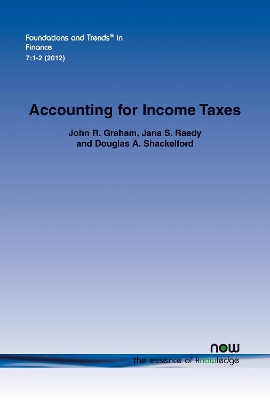Foundations and Trends (R) in Finance
1 total work
Accounting for Income Taxes
by John R Graham, Jana S. Ready, and Douglas A. Shackelford
Published 18 December 2012
This is the most comprehensive review of AFIT research. It is designed both to introduce new scholars to this field and to encourage active researchers to expand frontiers related to accounting for income taxes. It includes both a primer about the rules governing AFIT (Sections 3-4) and a review of the scholarly studies in the field (Sections 5-8).
The primer uses accessible examples and clear language to express essential AFIT rules and institutional features. Section 3 reviews the basic rules and institutional details governing AFIT. Section 4 discusses ways that researchers, policymakers, and other interested parties can use the tax information in financial statements to better approximate information in the tax return.
The second half of the monograph reviews the extant scholarly studies by splitting the research literature into four topics: earnings management, the association between book-tax differences and earnings characteristics, the equity market pricing of information in the tax accounts, and book-tax conformity. Section 5 focuses on the use of the tax accounts to manage earnings through the valuation allowance, the income tax contingency, and permanently reinvested foreign earnings. Section 6 discusses the association between book-tax differences and earnings characteristics, namely earnings growth and earnings persistence. Section 7 explores how tax information is reflected in share prices. Section 8 reviews the increased alignment of accounting for book purposes and tax purposes.
The remainder of the paper focuses on topics of general interest in the economics and econometric literatures. Section 9 highlights some issues of general importance including a theoretical framework to interpret and guide empirical AFIT studies, the disaggregated components of book-tax differences and research opportunities as the U.S. moves toward International Financial Reporting Standards (IFRS). Section 10 discusses econometric weaknesses that are common in AFIT research and proposes ways to mitigate their deleterious effects.
The primer uses accessible examples and clear language to express essential AFIT rules and institutional features. Section 3 reviews the basic rules and institutional details governing AFIT. Section 4 discusses ways that researchers, policymakers, and other interested parties can use the tax information in financial statements to better approximate information in the tax return.
The second half of the monograph reviews the extant scholarly studies by splitting the research literature into four topics: earnings management, the association between book-tax differences and earnings characteristics, the equity market pricing of information in the tax accounts, and book-tax conformity. Section 5 focuses on the use of the tax accounts to manage earnings through the valuation allowance, the income tax contingency, and permanently reinvested foreign earnings. Section 6 discusses the association between book-tax differences and earnings characteristics, namely earnings growth and earnings persistence. Section 7 explores how tax information is reflected in share prices. Section 8 reviews the increased alignment of accounting for book purposes and tax purposes.
The remainder of the paper focuses on topics of general interest in the economics and econometric literatures. Section 9 highlights some issues of general importance including a theoretical framework to interpret and guide empirical AFIT studies, the disaggregated components of book-tax differences and research opportunities as the U.S. moves toward International Financial Reporting Standards (IFRS). Section 10 discusses econometric weaknesses that are common in AFIT research and proposes ways to mitigate their deleterious effects.
